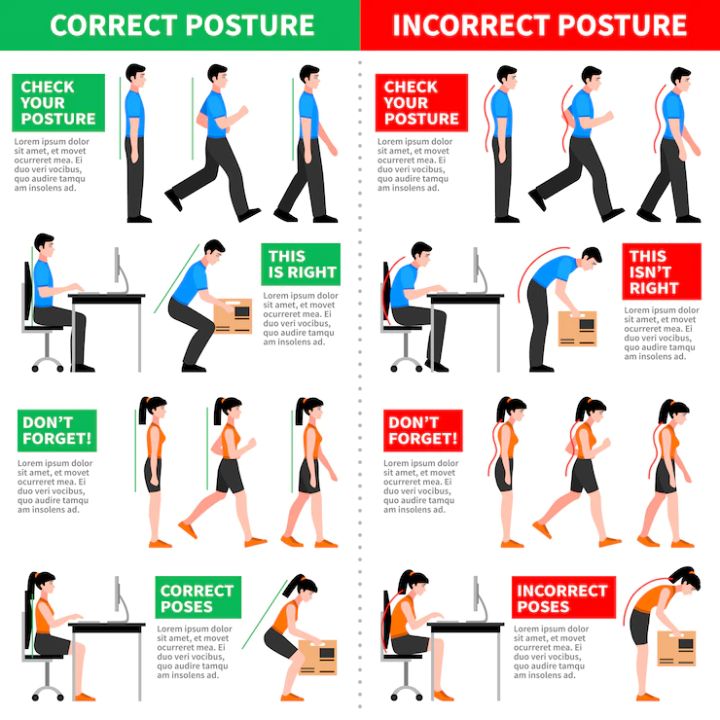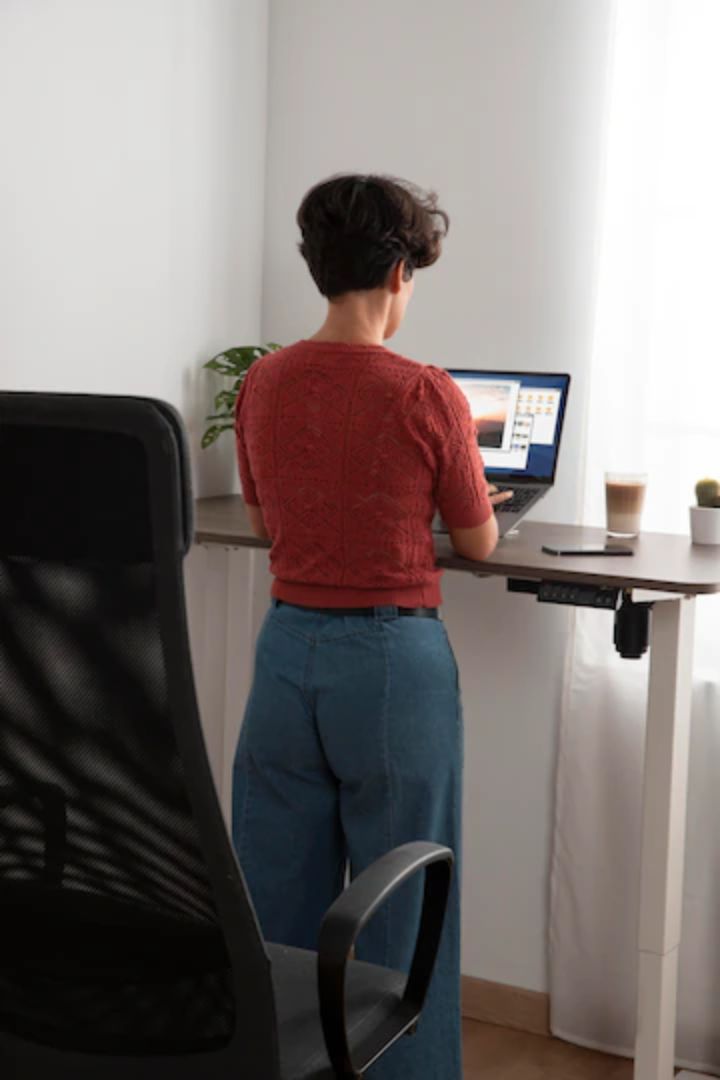Good posture not only makes you look confident and poised, but it also has numerous health benefits. Correct posture can improve your breathing, reduce strain on your joints and muscles, and even boost your mood.
Posture improvement for correct posture is vital for good health and well-being. Many people don’t realize the negative effects of poor posture on the body. Poor posture can lead to a range of problems, including back pain, neck pain, headaches, and even breathing difficulties.
On the other hand, maintaining good posture can lead to a range of benefits. Good posture helps you breathe easier, reduces the risk of injury, and even increases your energy levels.

Photo Credit: macrovector
Correct posture means keeping your body in alignment. This means keeping your ears, shoulders, and hips in a straight line. When you sit or stand with good posture, your body is more relaxed and your joints are less strained.
For posture improvement, becoming aware of your body’s position throughout the day is important. Take regular breaks, practice stretching exercises, and try to maintain good posture while performing everyday activities. With practice, good posture can become second nature, leading to a healthier and more comfortable future.
Many people experience posture problems due to poor habits, genetics, or physical impairments. These issues can cause discomfort, pain, and long-term health problems if unaddressed. Individuals can improve their overall health and well-being by identifying common problems and taking steps for posture improvement.
Rounded shoulders are a common posture problem that occurs when the shoulders slump forward. This can be caused by prolonged sitting or standing improperly, carrying a heavy bag, or weak muscles. Certain exercises can be carried out for posture improvement if you are dealing with rounder shoulders:
Forward head posture is characterized by a head that juts forward of the shoulders, leading to neck and upper back pain. This can be caused by sitting at a desk for long periods, carrying a heavy bag, or poor sleeping posture. For posture improvement, individuals can try these exercises:
By practicing these exercises and making small adjustments to their daily routine, individuals can correct common posture problems and enjoy the benefits of good posture.

Photo Credit: diana_grytsku
Core muscles play a critical role in maintaining good posture. They help support the spine, hips, and pelvis and promote healthy alignment of the body. For individuals posture improvement can be carried out by incorporating specific exercises that target the core muscles and reduce the risk of developing pain or discomfort.
Planks are an effective exercise for strengthening the core muscles that help in posture improvement. Begin by getting into a push-up position, then lower your forearms to the ground. Keep your body straight and hold the position for as long as possible. Aim to hold the plank for 30 seconds to start and gradually increase the duration as your core strength improves.
The dead bug exercise is an excellent way to engage the deep core muscles that support posture. Start by lying on your back with your arms extended toward the ceiling and your knees bent at a 90-degree angle. Slowly lower your right arm and left leg toward the floor while keeping your core engaged. Return to the starting position and repeat with the opposite arm and leg. Aim to complete 10 repetitions on each side.
The bird dog exercise targets several core muscles, including the lower back, hips, and abs. Begin on your hands and knees, with your wrists directly under your shoulders and your knees under your hips. Slowly lift your right arm and extend it straight out in front of you, while simultaneously lifting your left leg and extending it behind you. Hold the position for a few seconds, then return to the starting position and repeat with the opposite arm and leg. Aim to complete 10 repetitions on each side.
The glute bridge exercise targets the glutes and lower back muscles, which are essential in maintaining proper posture. Lie on your back with your knees bent and your feet flat on the ground. Lift your pelvis off the floor, keeping your core engaged and squeezing your glutes. Hold the position for a few seconds, then lower your pelvis back to the ground and repeat. Aim to complete 10-12 repetitions.
By incorporating these exercises into a regular workout routine, individuals can strengthen their core muscles and posture improvement will be evident over time.
In addition to exercises and stretching, ergonomics plays a significant role in posture improvement. Ergonomics is the science of designing and arranging workspaces, products, and systems for maximum efficiency and safety.

Photo Credit: Freepik
By incorporating ergonomics into your workspace and daily life, you can improve your body’s posture alignment and reduce the risk of strain and injury.
One of the most important steps in posture improvement through ergonomics is setting up an ergonomic workspace. This includes your chair, desk, and computer monitor.
In addition to your chair, desk, and computer monitor, other furniture can help with posture improvement. Consider investing in an ergonomic office chair or standing desk. These options promote proper alignment and reduce the risk of strain or injury.
Throughout the day, it’s essential to maintain proper body alignment to support good posture. This includes standing or sitting up straight, keeping your shoulders relaxed, and engaging your core muscles. Also, avoid crossing your legs or ankles, which can reduce your balance and alignment.
Along with posture exercises and ergonomics, there are a variety of tools and accessories that can aid in posture improvement and support.
Posture-correcting braces can be a helpful tool for individuals who have trouble maintaining good posture.

Photo Credit: tonodiaz
These braces pull the shoulders back and align the spine, encouraging the wearer to sit or stand up straight. It is important to note that posture braces should not be relied on as a long-term solution, but rather as a supplement to posture improvement techniques.
Investing in an ergonomic chair can also significantly impact posture improvement. These chairs are designed to provide proper support for the back and encourage proper alignment. Look for chairs with adjustable features, such as height and lumbar support, for the best results.
Various other accessories can aid in posture support and improvement, such as lumbar pillows, footrests, and standing desks. When choosing accessories, consider your specific posture needs and consult with a healthcare professional if necessary.
Posture improvement is not just about doing exercises or using posture-correcting tools. It also involves making small changes in your daily routine to promote better body alignment and reduce the strain on your muscles and joints. Here are some practical tips on how to incorporate posture improvement into your daily life:
The first step to improving your posture is to be conscious of how you hold your body. Pay attention to your alignment while standing, sitting, and walking throughout the day. Make sure your shoulders are relaxed, your spine is straight, and your weight is evenly distributed on both feet.
Sitting or standing in the same position for long periods can cause stress on your muscles and joints. Take frequent breaks to stretch, move around, and adjust your posture. This can help prevent discomfort and improve circulation.
When performing everyday activities such as lifting objects or bending down, be mindful of your posture. Avoid straining your back or neck by using proper lifting techniques and maintaining a straight spine.
If you spend a lot of time working at a desk, having an ergonomic workstation is important. Adjust your chair, keyboard, and monitor to the correct height and distance to promote good posture and reduce the risk of strain injuries.
Regular exercise, such as walking, swimming, or yoga, can help strengthen your core muscles, improve your flexibility, and boost your posture. Aim for at least 30 minutes of physical activity each day to maintain a healthy spine and prevent postural problems.
Incorporating these tips into your daily life can promote better posture and reduce the risk of related health problems. Remember that good posture is not an overnight fix but a gradual process that requires consistency and dedication. Keep practising these habits, and you will soon notice a positive change in your overall well-being.
It’s important to prioritise good posture in your daily life, as it can significantly impact your long-term health and well-being. By maintaining correct posture, you can prevent a range of issues such as back pain, muscle tension, and fatigue.

Photo Credit: macrovector
Remember that good posture is not just about sitting up straight but also about maintaining proper alignment throughout the day. This means being mindful of your posture while standing, walking, and even sleeping.
One of the best ways to maintain good posture is to make it a daily habit. This can include taking regular breaks to stretch and move around, practising mindfulness during work or leisure activities, and using reminders to check your posture throughout the day.
You can also incorporate posture exercises and stretches into your daily routines, such as yoga or Pilates, to strengthen the core muscles that support good posture.
Another key aspect of maintaining good posture is setting up an ergonomic workstation and using supportive furniture. This can include investing in an ergonomic chair and desk, using a posture-correcting brace, and practising proper body alignment while using electronic devices.
Additionally, posture support tools and accessories such as lumbar cushions and footrests can help alleviate any existing posture problems and provide added support throughout the day.
Maintaining good posture can have a range of benefits for your overall health and well-being. Not only can it prevent physical issues such as back pain and muscle tension, but it can also improve confidence and presence.
You can enjoy a healthier, more comfortable future by prioritizing good posture and incorporating posture improvement techniques into your daily life.
A: Good posture is important because it helps maintain the correct alignment of the body, reducing strain on muscles, joints, and ligaments. It can also improve breathing, digestion, and overall physical and mental well-being.
A: Common posture problems include slouching, hunching, and rounded shoulders. These issues can lead to back pain, neck tension, and poor spinal alignment.
A: To correct posture, practising exercises that strengthen the core muscles and stretch tight muscles is important. Maintaining proper alignment and practising good ergonomics can help improve posture over time.
A: Yes, some exercises specifically target the core muscles and help improve posture. Examples include planks, bridges, and shoulder blade squeezes. It is important to perform these exercises correctly and gradually increase intensity.